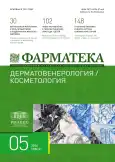Stevens-Johnson syndrome and toxic epidermal necrolysis
- Authors: Yunusovа E.I.1, Yusupovа L.A.1, Garaeva Z.S.1, Mavlyutova G.I.1
-
Affiliations:
- Kazan State Medical Academy – Branch Campus of the Russian Medical Academy of Continuous Professional Education
- Issue: Vol 31, No 5 (2024)
- Pages: 40-45
- Section: Reviews
- URL: https://journal-vniispk.ru/2073-4034/article/view/267797
- DOI: https://doi.org/10.18565/pharmateca.2024.5.40-45
- ID: 267797
Cite item
Abstract
Stevens-Johnson syndrome and toxic epidermal necrolysis are rare and life-threatening mucocutaneous diseases that occur almost exclusively as a result of adverse drug reactions, although there are rare cases associated with infection, immunization, or malignancy. Stevens-Johnson syndrome and toxic epidermal necrolysis are often accompanied by fever, malaise, upper respiratory symptoms, difficulty swallowing, and pain or a burning sensation of the skin and mucous membranes. These symptoms may precede skin manifestations for up to 3 days. Detachment of the epidermis usually begins on the trunk, then spreads to the limbs, head and neck. In addition, more than 90% of patients have lesions of the oral mucosa, eyes or genitals. Less commonly, the mucosa of the respiratory tract and gastrointestinal tract may be affected, resulting in significant morbidity and mortality. Stevens-Johnson syndrome and toxic epidermal necrolysis usually occur between days 7 and 21 after starting treatment, increasing the dose, or changing the brand of the responsible drug. In addition, certain groups of patients are at increased risk of developing these diseases when exposed to certain medications, including patients with human immunodeficiency virus infection, patients receiving concomitant radiation therapy, and anticonvulsant medications. The article provides etiopathogenetic aspects and features of the management of patients with Stevens-Johnson syndrome and toxic epidermal necrolysis.
Full Text
##article.viewOnOriginalSite##About the authors
E. I. Yunusovа
Kazan State Medical Academy – Branch Campus of the Russian Medical Academy of Continuous Professional Education
Email: yuluizadoc@hotmail.com
ORCID iD: 0000-0002-4550-9578
SPIN-code: 8514-0058
Russian Federation, Kazan
L. A. Yusupovа
Kazan State Medical Academy – Branch Campus of the Russian Medical Academy of Continuous Professional Education
Author for correspondence.
Email: yuluizadoc@hotmail.com
ORCID iD: 0000-0001-8937-2158
SPIN-code: 5743-6872
Dr. Sci. (Med.), Professor, Head of the Department of Dermatovenereology and Cosmetology
Russian Federation, KazanZ. Sh. Garaeva
Kazan State Medical Academy – Branch Campus of the Russian Medical Academy of Continuous Professional Education
Email: yuluizadoc@hotmail.com
ORCID iD: 0000-0001-9096-0563
SPIN-code: 3156-8170
Russian Federation, Kazan
G. I. Mavlyutova
Kazan State Medical Academy – Branch Campus of the Russian Medical Academy of Continuous Professional Education
Email: yuluizadoc@hotmail.com
ORCID iD: 0000-0002-4652-8869
SPIN-code: 3427-8924
Russian Federation, Kazan
References
- Mockenhaupt М., Rouget J.C. Epidermal necrolysis (Stevens-Johnson syndrome and toxic epidermal necrolysis). Fitzpatrick’s Dermatology, 9th Edition. 2022;7(44):733.
- Фомина Д.С., Проценко Д.С., Плавунов Н.Ф. Синдром Стивенса–Джонсона/Лайелла у взрослых: диагностика, маршрутизация, правила ведения/лечения, реабилитация. М., 2022. [Fomina D.S., Protsenko D.S., Plavunov N.F. Stevens-Johnson/Lyell syndrome in adults: diagnostics, routing, management/treatment rules, rehabilitation. M., 2022. (In Russ.)].
- Ямкина Н.С., Боярко В.В., Букреева Е.Б. Клинический случай синдрома Стивенса – Джонсона. Сибирский журнал клинической и экспериментальной медицины. 2023;38(2):248–52. [Yamkina N.S., Boyarko V.V., Bukreeva E.B. Clinical case of Stevens-Johnson syndrome. Sibirskij zhurnal klinicheskoj i eksperimental’noj mediciny. 2023;38(2):248–52. (In Russ.)].
- Родин А.Ю., Сердюкова Е.А. Токсический эпидермонекролиз (синдром Лайелла) на прием парацетамола и глибенкламида. Фарматека.2015;s1–15:60–3. [Rodin A.Yu., Serdyukova E.A. Toxic epidermal necrolysis (Lyell’s syndrome) against the background of use of paracetamol and maninil. Farmateka.2015;s1–15:60–3. (In Russ.)].
- Клинические рекомендации. Синдром Стивенса–Джонсона. Российское общество дерматовенерологов и косметологов, 2020. [Clinical guidelines. Stevens-Johnson syndrome. Russian Society of Dermatovenerologists and Cosmetologists, 2020. (In Russ.)].
- Барденникова С.И., Пеньтковская О.С., Исаева Е.К. Синдром Стивенса–Джонсона – иммунная катастрофа. Русский медицинский журнал. Мать и дитя. 2019:66–72. [Bardennikova S.I., Pen’tkovskaya O.S., Isaeva E.K. Stevens-Johnson syndrome is an immune catastrophe. Russkij medicinskij zhurnal. Mat’ i ditya. 2019:66–72. (In Russ.)].
- Аюпова К.Р., Юсупова Л.А. Розацеа: тригерные факторы и сопутствующие заболевания. Фарматека. 2023;29(8):20–26. [Ayupova K.R., Yusupova L.A. Rosacea: trigger factors and comorbidities. Farmateka. 2023;29(8):20–26. (In Russ.)]. doi: 10.18565/pharmateca.2023.8.20-26.
- Bologna J.2, Jorizzo J.L., Shaffer J.V. Dermatology. Philadelphia: Elzevir Saunders, 2012.
- Chung V.H., Hung Xi, Yang J.I., et al. Granulisin is a key mediator of disseminated keratinocyte death in Stevens-Johnson syndrome and toxic epidermal necrolysis. Nat Med. 2008;14(12):1343–50. doi: 10.1038/nm.1884.
- Аюпова К.Р., Юсупова Л.А. Современные особенности патогенетических механизмов розацеа. Фарматека. 2022;29(8):43–7. [Ayupo-va K.R., Yusupova L.A. Modern features of the pathogenetic mechanisms of rosacea. Farmateka. 2022;29(8):43–7. (In Russ.)]. doi: 10.18565/pharmateca.2022.8.43-47.
- Лысенко М.А. Синдром Стивенса–Джонсона и синдром Лайелла у взрослых. М., 2023. [Lysenko M.A. Stevens-Johnson syndrome and Lyell’s syndrome in adults. M., 2023. In Russ.)].
- Юсупова Л.А. Современное состояние проблемы эксфолиативного дерматита. Лечащий врач. 2019;11:6–8 [Yusupova L.A. The current state of the problem of exfoliative dermatitis. Lechashchii vrach. 2019;11:6–8. (In Russ.)].
- Кажжанова А.М., Юсупова Л.А. Патогенетические механизмы гнездной алопеции. Фарматека. 2023;29(8):47–51. [Kazhzhanova A.M., Yusupova L.A. Pathogenetic mechanisms of alopecia areata. Farmateka. 2023;29(8):47–51. (In Russ.)]. doi: 10.18565/pharmateca.2023.8.47-51.
- Юсупова Л.А. Современный взгляд на проблему старения кожи. Лечащий врач. 2017; 6:75. [Yusupova L.A. Modern view on the problem of skin aging. Lechashchii vrach. 2017;6:75. (In Russ.)].
- Pisano S., Brown M., Giambusaria A. Comparison of international recommendations for the treatment of Stevens-Johnson syndrome and toxic epidermal necrolysis. Int J Dermatol. 2023;62(3):397–403. Doi: 10.1111/ ijd.16561.
Supplementary files








